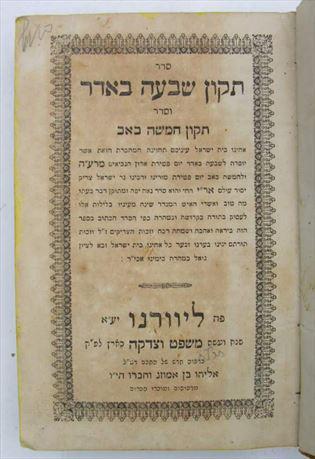
Rabbi Aḥa bar Ḥanina says: That day was the sixth day of the month of Sivan. The ministering angels said before the Holy One, Blessed be He: Master of the Universe, should the one who in the future will receive the Torah on Mount Sinai on this day be stricken on this day? As this was also the date on which the Torah was received. The Gemara asks: Granted, according to the one who says that Moses was placed in the water on the sixth of Sivan, you find that there can be three months during which Moses was hidden after his birth; as the Master said (Tosefta 11:7): Moses died on the seventh of Adar, and Moses was born on the seventh of Adar. And based on this, from the seventh of Adar until the sixth of Sivan there are three months, which correspond to the three months Moses was hidden before being placed in the water. But according to the one who says that it was on the twenty-first of Nisan, how can you find that he was hidden for three months? The Gemara answers: That year was a leap year in which there were two months of Adar. Moses was hidden most of the first month of the three, from the seventh day of the first Adar when he was born, and most of the last month of the three, i.e., all of Nisan until the twenty-first, and the entire middle one. All of this together is considered as three months.
(ג) וילך משה וידבר את הדברים האלה אל כל ישראל. בן מאה ועשרים שנה אנכי היום. יתכן לומר כי היו ימיו ק"כ שנה כנגד ק"כ יום שעמד בהר, ארבעים יום ראשונים לקבל הלוחות, ארבעים יום שניים להתפלל על עון העגל, ארבעים שלשיים לקבל לוחות שניות, וזה טעם אנכי ולא אמר אני. ודרשו רז"ל היום מלאו ימי ושנותי, היום נולדתי והיום אמות. וכן אמר בתחלת דבריו (דברים כ״ט:ט׳) אתם נצבים היום, כל הענין דבק, והכל היה ביום מיתתו. והיום זה ז' באדר היה והוא סוף שנת הארבעים, בו ביום מת משה בו ביום נולד. בו ביום מת משה, הוא שכתוב בסוף התורה (שם לד) ויבכו בני ישראל את משה בערבות מואב שלשים יום ויתמו ימי בכי אבל משה, וראוי להדביק אל הכתוב הזה שבסוף התורה מה שכתוב בתחלת יהושע (יהושע א׳:י״א) ויצו יהושע את שוטרי העם הכינו לכם צדה כי בעוד שלשת ימים אתם עוברים את הירדן. ומי שמחבר הכתובים זה עם זה ימצא הענין מבואר כי לא צוה יהושע להכין צדה עד שתמו ימי בכי אבל משה, ולכך הוצרך הכתוב לומר ויתמו ימי בכי אבל משה, והזכיר שם הכתוב (שם ד) והעם עלו מן הירדן בעשור לחדש הראשון, ואם תמנה למפרע מעשרה בניסן ל"ג יום והם שלשה ימים לצדה ושלשים לאבלו של משה, תמצא יום מיתתו בז' באדר. בו ביום נולד משה, שכתוב (שמות ב׳:ג׳) ולא יכלה עוד הצפינו, והיה זה בששה בסיון, יום שהיה עתיד לקבל התורה שנתוסף בו עוצם אורה באותו יום לרמוז על גדולתו באותו יום, ועל כן לא יכלה עוד הצפינו, ועשתה תחבולה לשומו בתיבת גומא כדי להסתיר את גופו מפני תוקף אורו. ואם תחשוב מששה בסיון למפרע שלשה ירחים תמצא ים לידתו בז' באדר, ולכך אמר ירחים שהם חדשי הלבנה, והן אדר ניסן אייר, שנים חסרים ואחד מלא, ולא אמר חדשים לפי שהחדש חלק אחד משנים עשר שבשנה ואינן מוסיפין ולא גורעין, מה שאין כן חדשי הלבנה שהן מוסיפים וגורעין, ומפני זה הזכיר לשון ירחים כדי שיתבאר לנו מזה יום לידת הנביא. והנה זה מבואר מן הכתובים כי בז' באדר נולד משה ובו ביום מת וזהו מה שדרשו רז"ל שהקב"ה ממלא שנותיהם של צדיקים מיום ליום שנאמר (שם כג) את מספר ימיך אמלא.
(3) וילך משה וידבר את הדברים האלה אל כל ישראל. בן מאה ועשרים שנה אנכי היום, וגו', “Moses went and spoke these words to all of Israel. ‘I am 120 years old this day.’” It is possible that the 120 years Moses lived corresponded to the 120 days he spent on Mount Sinai. During the first 40 days he received the first set of Tablets. During the second 40 days he pleaded for G’d to forgive the people the sin of the golden calf; he spent the next 40 days on the mountain in order to receive the second set of Tablets. This may be the reason why he used the term אנכי instead of אני.
Our sages in Sotah 13 feel that he meant to say that on that day he was precisely 120 years old, i.e. that he died on the same day of the same month as he had been born. This may also be the reason why he used the word היום at the beginning of the previous Parshah, so that all these speeches took place on the same day. The day in question was the seventh day of Adar at the end of the Israelites 40th year in the desert. We have further proof of this in 34,8 where the Torah reported that the people mourned Moses for 30 days during which they did not journey. The Torah states explicitly that the days of Moses’ mourning came to an end. It is proper to read this verse in conjunction with Joshua 1,10: “Joshua commanded the law-enforcement officers of the people: ‘prepare for yourselves provisions for in another three days you will cross the river Jordan.’” Anyone reading these two verses together will realize that Joshua would not command the people to prepare these provisions until the mourning period for Moses had passed. To make this plain, the Torah had to write the verse: “the days of crying for (the death of) Moses had concluded.” The Book of Joshua 4,19 reports that the Jewish people completed crossing the river Jordan on the tenth of the first month, i.e. 3 days after the conclusion of the mourning period for Moses. By counting backwards you will arrive at the date of the 7th Adar as the date on which Moses had died. When the Torah in Exodus 2,3 reported that Moses’ mother was unable to hide him any longer, the date referred to is the 6th of Sivan, the day on which the revelation at Mount Sinai took place 80 years later. On that day, the light which filled only his parents’ home on the day he was born became so powerful that it shone for the whole Jewish nation. The light which had filled the house of Amram had already forecast the eventual greatness of the boy that had been born to Yocheved. The reason Yocheved had to hide Moses in a basket, well insulated, was that the light surrounding the baby had become so much stronger that it represented a danger to the family. The Torah speaks of Yocheved having hidden Moses for שלשה ירחים ‘three lunar months,” rather than שלשה חדשים, “three months,” (Exodus 2,2) to indicate that these were lunar months. The months Adar, Nisan, and Iyar are 29,30, and 29 days long, respectively. This gives us a total of 88 days during which Moses was kept “hidden” at home, or it takes us back to the 7th day of Adar as Moses’ birthday. From all this it becomes clear that Moses died on the same day of the same month on which he had been born. The word חדש implies a period which equals 1/12th of the year, something not subject to variation either by adding or subtracting from it. The same is not true of the period known as ירח, a period which may comprise either 29 or 30 days. The reason why the Torah used the term ירחים in the verse mentioned was to enable us to calculate the precise date on which Moses was born. This prompted our sages in Kiddushin 38 to state that G’d completes the life cycle of the righteous from day to day (to grant them whole years) something they base on Exodus 23,26: את מספר ימיך אמלא, “I will fill (round out) the number of your days (meaning “years”).
Among the other customs associated with this date are that local Jewish burial societies hold their annual fundraising dinners on this date to raise awareness of the important work done by the chevra kadisha. Thus, giving to such organizations is a mitzvah associated with this date.
The Tzidkat'cha prayer may also be recited. This prayer is comprised of three verses from Tehillim - 36:7, 71:19, and 119:142 (in Sephardic order; Nusach Ashkenaz reverses them). In the weekly Shabbat liturgy, its placement is between the Amidah and the Qaddish Shalem of the Minchah (afternoon) prayers.
(7) Your beneficence is like the high mountains; Your justice like the great deep; man and beast You deliver, O LORD.
(19) Your beneficence, high as the heavens, O God, You who have done great things; O God, who is Your peer!
(קמב) צִדְקָתְךָ֣ צֶ֣דֶק לְעוֹלָ֑ם וְֽתוֹרָתְךָ֥ אֱמֶֽת׃
(142) Your righteousness is eternal; Your teaching is true.
(ב) צִדְקָתְךָ צֶדֶק לְעולָם וְתורָתְךָ אֱמֶת:
(ג) וְצִדְקָתְךָ אֱלהִים עַד מָרום אֲשֶׁר עָשיתָ גְדולות אֱלהִים מִי כָמוךָ:
(ד) צִדְקָתְךָ כְּהַרְרֵי אֵל מִשְׁפָּטֶיךָ תְּהום רַבָּה אָדָם וּבְהֵמָה תּושִׁיעַ ה':
(2) Your righteousness is an everlasting righteousness, and Your Torah is truth.
(3) And Your righteousness, O G-d, is unto the high heavens, You, Who have done great things, O G-d. Who is like You?
(4) Your righteousness is like the mighty mountains - Your judgment is like the vast deep waters. Man and beast You save, HASHEM.
קל צום




